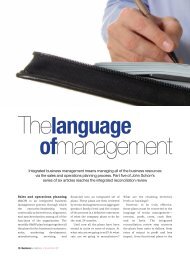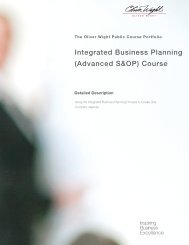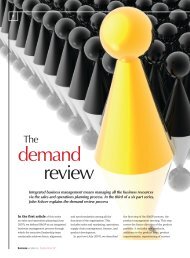The Proven Path - Oliver Wight Americas
The Proven Path - Oliver Wight Americas
The Proven Path - Oliver Wight Americas
You also want an ePaper? Increase the reach of your titles
YUMPU automatically turns print PDFs into web optimized ePapers that Google loves.
<strong>The</strong><br />
proven<br />
path<br />
Integrated business management means managing all<br />
of the business resources via the sales and operations<br />
planning process. <strong>The</strong> final part of John Schorr’s series of<br />
six articles deals with the management business review<br />
8 Businessexcellence January 08
Strategicmanagement<br />
<strong>The</strong> management business<br />
review (MBR) is the final step in<br />
the sales and operations planning<br />
(S&OP) process (Figure 1). Each<br />
senior manager should receive<br />
an S&OP information packet at<br />
least twenty-four hours before the<br />
scheduled meeting. <strong>The</strong> packet<br />
contains the performance measures<br />
which, in effect, are a report card<br />
of how the business is performing.<br />
It also includes the business and<br />
departmental assumptions, and the<br />
key issues raised from the individual<br />
product review, demand review,<br />
supply review, and integrated<br />
reconciliation meetings.<br />
All of the family spreadsheets, roughcut<br />
capacity plans, new product and<br />
new activities summaries, business<br />
project summaries, and the financial<br />
projections are also a part of the<br />
S&OP packet. Key strategic issues<br />
requiring direction and decisions will<br />
also be included. With all of this data<br />
and information it is time for the<br />
senior management team to make the<br />
appropriate decisions and provide the<br />
necessary direction that will guide the<br />
business into the future.<br />
Sales & operations planning is an<br />
integrated business management<br />
process through which the executive/<br />
leadership team continually<br />
achieves focus, alignment and<br />
synchronization among all of the<br />
functions of the organization. <strong>The</strong><br />
monthly S&OP plan is reviewed by<br />
senior management and the output of<br />
the process is a definitive statement<br />
of what the company plans to do over<br />
the next twenty-four months.<br />
<strong>The</strong> attendees at the management<br />
business review meeting are the<br />
executive management team—the<br />
president and all direct reports.<br />
<strong>The</strong> president is the owner of this<br />
meeting. Other participants who<br />
may regularly attend include the<br />
new product coordinator, demand<br />
manager, supply manager, and the<br />
finance manager/S&OP coordinator.<br />
<strong>The</strong>se are the individuals who have<br />
facilitated the collection of all the<br />
data in the packet and participated<br />
in creating the various scenarios<br />
that will be presented in the S&OP<br />
“<strong>The</strong> output from the management<br />
review meeting is the approved plan,<br />
defining the decisions made and the<br />
agreed actions to be taken”<br />
meeting. <strong>The</strong>y are there to answer<br />
questions or clarify issues which<br />
may arise during the meeting.<br />
<strong>The</strong> management business review<br />
meeting should be a crisp, clear<br />
decision-making meeting, which will<br />
usually take between two and four<br />
hours, depending upon the maturity<br />
of the S&OP process. If major<br />
strategic issues are to be addressed,<br />
these may be the subject of an<br />
extension of the normal two to four<br />
hours. <strong>The</strong> MBR meeting includes<br />
all the information that is required<br />
to make the necessary decisions in<br />
the S&OP/MBR packet. <strong>The</strong> senior<br />
managers must review the S&OP<br />
information packet prior to the<br />
meeting to assure that a focused<br />
management business review<br />
meeting can take<br />
place. <strong>The</strong> MBR<br />
is not meant to<br />
be a “discovery”<br />
meeting,<br />
but<br />
rather a decision<br />
making<br />
direction setting meeting.<br />
and<br />
<strong>The</strong> meeting typically begins with<br />
a review of the outstanding action<br />
items from the previous month.<br />
This is followed by a presentation<br />
of the decisions that are required<br />
to be made this month, along with<br />
decisions that may be necessitated<br />
in the future. This helps to focus<br />
the meeting on what needs to be<br />
decided over the next few hours.<br />
After reviewing the decisions that<br />
January 08 Businessexcellence 9
are required, the president typically<br />
spends a few minutes addressing<br />
those special issues that need to be<br />
covered during the session.<br />
<strong>The</strong> head of finance then reviews<br />
the performance metrics and<br />
gives an overview of the financial<br />
projections contained in the packet.<br />
<strong>The</strong> S&OP packet ideally contains a<br />
dashboard with all the key metrics.<br />
<strong>The</strong>se metrics include the critical<br />
operational, financial, and strategic<br />
measures that are essential for<br />
running the business.<br />
<strong>The</strong> dashboard example (Figure<br />
2) has forty-two measures. Only<br />
those metrics shown in red are<br />
discussed, and the discussions are<br />
mainly around the actions taken to<br />
move those metrics back from red or<br />
yellow to green. If a measure is green<br />
and under control, there is no reason<br />
to spend time discussing it. This<br />
meeting is centered around the gaps<br />
to the strategic plans, the business<br />
plans, and the performance metrics.<br />
Next, the business and<br />
departmental assumptions are<br />
discussed. This may include a<br />
SWOT (strengths, weaknesses,<br />
opportunities, and threats)<br />
discussion when there are issues in<br />
a given area.<br />
We are striving to achieve a senior<br />
management team consensus on<br />
the assumptions. Once everyone<br />
on the team understands the<br />
assumptions behind the numbers<br />
being presented and they reach<br />
consensus on those assumptions,<br />
the chances are fairly good they<br />
also will agree on the numbers in<br />
the S&OP family plans.<br />
Having established the decisions<br />
needed from the meeting, discussed<br />
the special issues that need to<br />
be addressed and reviewed the<br />
performance metrics and the<br />
assumptions, it is time to proceed<br />
with the family-by-family review. This<br />
phase of the meeting is traditionally<br />
led by the president and often takes<br />
the greatest proportion of the time<br />
involved in the meeting.<br />
When there are no changes or<br />
issues from the<br />
previous month’s<br />
meeting in a given<br />
family, it is noted<br />
and the family is not<br />
discussed. Rather,<br />
the focus for this<br />
part of the meeting is<br />
on the changes that<br />
are occurring in the<br />
individual family plans<br />
and their implications,<br />
strategic, operational<br />
and financial.<br />
Each family typically<br />
has a one page summary<br />
(Figure 3) that focuses<br />
on the information<br />
management needs<br />
to make the required<br />
decisions. This<br />
summary includes the<br />
graphical presentations<br />
of the demand plan<br />
versus the business<br />
plan, the supply/ demand/ inventory/<br />
backlog balance, and the gaps to the<br />
plan. <strong>The</strong> summary describes the<br />
changes from the previous month, the<br />
key assumptions, the vulnerabilities/<br />
opportunities, the decisions made<br />
in the integrated reconciliation<br />
meetings, and the decisions that will<br />
be required in this meeting. Scenarios<br />
that were developed in the previous<br />
review meetings (product, demand,<br />
supply, and integrated reconciliation)<br />
are presented to help the decisionmaking<br />
process. It is anticipated that<br />
the senior management team will<br />
make the appropriate decision(s) at<br />
this time.<br />
Following the family-by-family<br />
discussions, any new product,<br />
special project, or company-wide<br />
10 Businessexcellence January 08
Strategicmanagement<br />
project that needs management’s<br />
attention is addressed. <strong>The</strong>se<br />
discussions typically involve<br />
resource requirements, schedule<br />
attainment, or other critical issues<br />
that require senior<br />
m a n a g e m e n t ’ s<br />
attention or approval.<br />
<strong>The</strong> output from<br />
the management<br />
review meeting is<br />
the approved plan,<br />
defining the decisions<br />
made and the agreed<br />
actions to be taken.<br />
This plan will be the<br />
input to the various<br />
departments for their<br />
selected gap closing<br />
scenarios.<br />
A quick review<br />
of the meeting’s<br />
minutes is made. <strong>The</strong><br />
minutes will move<br />
to the participants<br />
for action, to the<br />
process step leaders<br />
for direction, to the<br />
coordinators of the<br />
process steps for<br />
execution, and often to a broader<br />
audience (key suppliers or key<br />
customers) for alignment. Because<br />
of this broad distribution of the<br />
minutes and the impact that the<br />
decisions will have on the various<br />
departments, it is always good<br />
practice to review the minutes<br />
before they are published to<br />
ensure they accurately state senior<br />
management’s direction.<br />
A meeting critique is the final<br />
agenda item. <strong>The</strong> goal of the critique<br />
is to constantly strive to improve<br />
the decision-making capability of<br />
the sales and operations planning<br />
meeting. In this critique ask<br />
questions such as: Are we doing the<br />
right things How well are we doing<br />
them Are we on the right track to<br />
world-class performance <strong>The</strong>se<br />
are critical questions for evaluating<br />
your sales and operations planning<br />
process. <strong>The</strong> answers will reflect<br />
the current levels of performance<br />
and reveal significant opportunities<br />
for improvement.<br />
A good reference for critiquing the<br />
meeting is to follow a guide such as<br />
<strong>The</strong> <strong>Oliver</strong> <strong>Wight</strong> Class A Checklist<br />
for Business Excellence, Sixth<br />
Edition. Regular use of the checklist<br />
generates a consistent means of<br />
assessing progress, identifying<br />
problems, allowing early correction<br />
to those problems, and comparing<br />
performance against established<br />
best practices. By comparing<br />
performance against established<br />
best practices, your team will<br />
become motivated to work in a more<br />
effective manner.<br />
Colleen Crum, a managing<br />
principal of <strong>Oliver</strong> <strong>Wight</strong> <strong>Americas</strong>,<br />
recently conducted a survey of forty<br />
companies to determine the range<br />
of benefits various companies have<br />
achieved since implementing a sales<br />
and operations planning process.<br />
<strong>The</strong> results are impressive, and<br />
include:<br />
• Increased forecast accuracy<br />
18 – 25 percent<br />
• Increased sales revenue<br />
10 – 25 percent<br />
• Increased on-time delivery<br />
10 – 50 percent<br />
• Inventory reduction<br />
18 – 46 percent<br />
• Safety stock reduction<br />
11 – 45 percent<br />
• Increased productivity<br />
30 – 45 percent<br />
One executive recently confided to me:<br />
“For once I have a handle on the business.”<br />
You, too, can approach and even surpass<br />
these results, once you begin to follow the<br />
‘proven path’ to successfully implement<br />
the best practice S&OP process described<br />
in this six article series.<br />
John E. Schorr, a principal with <strong>Oliver</strong> <strong>Wight</strong>, is one of the leading experts in sales & operations planning<br />
(S&P). Prior to joining <strong>Oliver</strong> <strong>Wight</strong>, John was involved in the implementation of MRP II at Haworth, where<br />
he was vice president of manufacturing, and Steelcase, where he was director of purchasing.<br />
January 08 Businessexcellence 11
















